Catch-Up HPV Testing May Help Prevent Cervical Cancer in Some Over Age 65
, by Linda Wang
Testing for the presence of cancer-causing types of the human papillomavirus (HPV) is now a standard part of screening for cervical cancer, some times with simultaneous Pap tests (known as co-testing). But cervical cancer screening is recommended to stop at age 65 in many places and, for a variety of reasons, many older adults stop getting screened for cervical cancer well before that age.
Results from a population-based study conducted in Denmark, however, suggest that it may be worthwhile for some individuals between ages 65 and 69 to get tested for HPV: those who haven’t had cervical cancer screening for at least 5 years.
In the new study, about 62% of women who were invited to undergo this “catch-up” testing for HPV (intervention group) had a test within the next year. In a comparison group of women not invited for catch-up testing, only about 2% had either a Pap test or an HPV test over the next year.
The rate of CIN2+ lesions diagnosed in the intervention group was significantly higher than in the comparison group (3.9 vs. 0.3 per 1,000 eligible women, respectively). CIN2+ lesions are often called precancers because these types of cell changes can go on to become cancer. Finding these lesions early allows doctors to remove them before they can progress.
Women who were furthest behind on regular screenings—that is, had one or no screenings since age 50—had nearly twice the rate of CIN2+ lesions as women who had been screened two or more times since age 50, the researchers found.
The study findings were published July 6 in PLOS Medicine.
“It may be time to reevaluate cervical cancer screening at older ages,” said lead investigator Mette Tranberg, Ph.D., of the University Research Clinic for Cancer Screening at Randers Regional Hospital in Denmark. “Our data show that it could really be beneficial to [offer catch-up HPV testing] for these older, insufficiently screened women.”
The findings support recommendations in some countries, such as the United States, where a history of negative screening results is recommended for stopping screening at age 65, after which the risk of a new HPV infection developing into cervical cancer is very low, said Nicolas Wentzensen, M.D., Ph.D., of NCI’s Division of Cancer Epidemiology and Genetics (DCEG), who was not involved in the study.
Dr. Tranberg cautioned, however, that catch-up HPV testing could have potential downsides.
As with any screening approach, she said, it’s important to weigh the potential benefits of catching precancers or early cancers with the potential harms. Those harms include being treated for lesions that would never have developed into cancer during a woman’s lifetime.
Overall, Dr. Wentzensen said, the study reinforces the importance of women continuing to stay up to date on cervical cancer screening as they get older.
“This study was able to evaluate the prevalence of precancer in this specific population. Understanding the prevalence of precancer is one part of the puzzle to inform screening recommendations in an any age group,” he said. “This study clearly shows that there [are potential precancers over age 65] and that offering an HPV test in this population to identify those who may need treatment could be helpful.”
The challenges of screening older individuals
Almost all cervical cancers are caused by infection with high-risk types of HPV, particularly HPV 16 and HPV 18. Most HPV infections go away on their own, but for some people an infection can persist for years and lead to abnormal cervical cells that form cervical lesions. If left untreated, these lesions may progress to cervical cancer.
Unlike Pap tests, which look for abnormal cells in a sample of cervical cells, an HPV test checks the cells for the presence of genetic material (DNA or RNA) from high-risk HPV types.
Many countries, including the United States, have begun transitioning to HPV testing as the primary approach to cervical cancer screening. Women who test positive for HPV are referred for follow-up testing, which may include a Pap test or colposcopy (visual inspection of the cervix under magnification) and a biopsy to see how abnormal the cells are and how much of the cervical tissue is affected.
HPV tests are very good at detecting infection with the virus, but because these tests have only been available for the past 10 or so years, most women over age 65 have never had one. Instead, most older women have had Pap tests for routine cervical cancer screening.
However, Pap tests are less effective in older women compared to younger women because physiological changes after menopause make it more difficult for doctors to collect samples from the part of the cervix where cell changes typically start.
Even though cervical cancer tends to be diagnosed at younger ages than many cancers—in the United States the median age at diagnosis is 50 years—it does affect older women.
Experts say new approaches to prevent cervical cancer in women over the age of 65 are needed because women over this age continue to be diagnosed with and die from the disease. In the United States, for example, women 65 and older account for more than 20% of new cases of cervical cancer and around 37% of deaths from the disease.
Dr. Tranberg and her colleagues wondered whether giving women over age 65, particularly those who have fallen behind on screening, a catch-up HPV test could help bridge this gap in cervical cancer prevention.
Catching up with an HPV test
In the study, more than 11,000 Danish women aged 65 to 69 from one region of Denmark were invited to get an HPV test. They were able to choose between having a cervical sample collected by their doctor or using a vaginal self-collection kit to be mailed back for testing, known as self-sampling.
Women were included if they had no record of screening in the past 5.5 years. A comparison group of about 33,400 Danish women from Denmark’s remaining four regions were offered usual care, which included getting a Pap test or HPV test as needed—for example, if they had vaginal bleeding.
About 62% of women in the catch-up testing group had an HPV test within 12 months, while only 2% of women in the comparison group got either a Pap test or HPV test within the same time frame.
Using patient records from a centralized data network in Denmark, the researchers compared the rates CIN2+ lesions diagnosed in the two groups. In the catch-up group, 3.9 out of every 1,000 eligible women were found to have a CIN2+ lesion, compared with 0.3 out of every 1,000 eligible women in the comparison group.
Those who had rarely or never been screened in their 50s and early 60s (“insufficiently screened”) were more than twice as likely to have CIN2+ lesions as those who had been screened at least twice during that same time (“routinely screened”).
Overall, more women in the catch-up testing group chose to get a cervical sample collected by a clinician than to do self-sampling. But those who were insufficiently screened were much more likely to choose self-collection than those who were routinely screened.
Among the 2,000 women who conducted the testing via self-collection at home, 161 were found to be HPV-positive. Of this group, all except one completed follow-up testing with their doctor within the next 6 months.
This finding, Dr. Tranberg said, suggests that offering the opportunity for self-collection may be appealing to women who prefer not to get screening from a provider.
Balancing risk versus benefit
The study's findings, Dr. Wentzensen said, highlight the importance of the recommendation in US cervical cancer screening guidelines that calls for women over 65 to continue screening until they have a series of normal results.
“We know there is risk [in this age group],” he said. “So clinicians need to work with patients to make sure they have had several consecutive normal HPV test results. For their patients who haven’t, he added, “you can’t just release them from screening.”
However, he cautioned that CIN2+ is not the best indicator of cervical cancer risk, because many of these lesions will never progress to cancer. A better measure, he said, would be CIN3+ lesions, which are much more likely to develop into cancer.
Dr. Tranberg acknowledged that CIN3+ would have been a better primary measure but, from a statistical standpoint, would have required an even larger study. However, the researchers did find that rates of CIN3+ were higher in the catch-up testing group than the comparison group.
Ultimately, Dr. Tranberg said, better tests and biomarkers are needed to differentiate between abnormalities that are harmless and abnormalities that will progress to cancer.
She also pointed out that given the potential harms of screening, such as overdiagnosis and overtreatment, it’s important to determine who would benefit most from receiving a catch-up HPV test.
One approach might be to offer catch-up testing to only those older women who have been insufficiently screened, and to make self-collection kits more widely available. HPV self-collection kits are already being used in several countries, including Denmark, and are under FDA review in the United States.
Meanwhile, Dr. Wentzensen and other DCEG colleagues are engaged in several collaborative efforts related to cervical cancer screening. They include initiatives to improve screening in communities where screening rates continue to lag (see below).
Screening centered around HPV testing “is now the preferred approach in most places in the world, and now it’s really a question of implementation and making sure that new developments reach the populations that need them the most,” he said.


